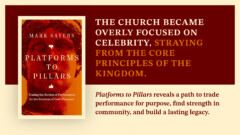Last week Ellison Research released a report on the use of internet technologies amongst churches. The results were consistent with the findings and predictions of the Barna Research Group three years earlier. The research found that while 90 percent of Protestant pastors use the internet for church related business, only about half of them pastor churches that have a web site of their own. The study also found that large churches were much more likely to have a web site than smaller ones. You can read the results of the study here.
This study was of interest to me because I own a web design company and have done extensive work for church and ministry sites. Generally my work for churches has involved overhauling existing sites that were terribly outdated and ineffective. I have had many small churches contact me to inquire about having me build a web site, but very few of these tiny ones have been willing to pay for a site, even when I drop my prices as low as I can go. I do try to do as much charity work as I can, but I do need some jobs to pay the bills, so have had to leave many of them without a site. Clearly budget is a concern for smaller churches. Many people do not know that hosting for web sites is now affordable as annual fees of $100 or less are becoming increasingly common. This is less than most churches spend on either Yellow Pages or newspaper advertising. I suspect most mid-sized churches have someone in their congregation that is capable of designing a web site, even if it is not a very good one, so they often are able to keep their design costs to nothing. In this way mid to large churches have a distinct advantage over small ones – percentages dictate that it is more likely that there will be someone in the church who can do the design work and consider it ministry.
You can tell a lot about a church by its web site (though as a web designer I may have more insight than most people). For example, pulling up a site that looks like it was made in 1996 and that has an awful midi version of Onward Christian Soldiers playing in the background of every page tells you that the site is probably run by a small fundamentalist church that created the site and has not updated it since. Alternatively, opening a site that is made in all Flash and has pulsating rock music in the background will show that the church is trying to appeal to Gen-X’ers and that they see the web site as a valuable part of their outreach.
Our church has a web site and I consider it a pretty good one (I was quite involved in the design and implementation). Almost every week I hear from someone in church that they or someone they met at church accessed the site before they came for the first time on a Sunday morning. What that tells me is that the web site becomes a critical first or second point of contact with potential church-goers. People may receive a postcard in the mail or see an advertisement in the newspaper and then visit the site to learn more about the church. Others find the church via search engines. Either way, most of the people who come to our church for the first time have first done their research by scouring our site to see what our church is about and what we can offer them.
The internet plays into the consumer mentality of our society. When we buy books online we tend to visit several competing sites to find who can get us the best bang for our buck. People seem to be doing the same with churches: they will shop around at the web sites of several local churches to find the one that most appeals to them. Ten years ago all the information you could find about a church was contained in a little 1 x 3 inch advertisement in the newspaper. After reading little more than the sermon titles of the numerous local churches, people were left to choose one. Today page after page of information, descriptions, pictures, video clips, sound bytes and testimonies are available to people before they ever set foot in a church. This allows the churches to break down walls and to reassure people about what they will experience. Many churches have a “what to expect” section on their sites that contains a blow-by-blow account of a typical church service so that nothing will take visitors by surprise.
I think it is becoming increasingly evident that a web site will soon be a necessity for all churches that seek to draw visitors. It is already becoming an indispensable aspect of outreach. At one time it was enough for organizations and companies just to have an internet presence, but already the trend is changing so that they require a good presence. An old, outdated site created as part of the pastor’s son’s high school project just is not enough anymore. Sites need to be good, they need to contain the right information, and they need to be updated.









